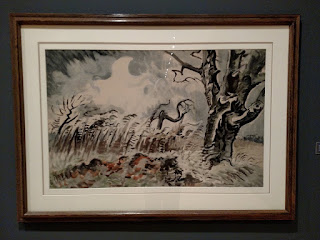Step 1: The Exhibition
Questions about the exhibit:
1. What is the title of the exhibit?
There were a couple of exhibits at the Burchfield Penney Art Gallery including: The Birthday Party: a Community of Artists, HERE!, and My First Exhibition: 50 Years with Charles E. Burchfield.
2. What is the theme of the exhibition?
Step 2: The Gallery
Questions about the physical space:
1. What type of lighting is used?
Birthday Party exhibit was very dim with track lighting focused on the artworks only. HERE! and the Burchfield exhibit were much brighter.
2. What colors are used on the walls?
The gallery used white, light gray, dark gray, and even a sage green on the walls.
3. What materials are used in the interior architecture of the space?
Stainless steel and wood were prevalent throughout the gallery. The entire gallery had a wood floor.
4. How is the movement of the viewer through the gallery space?
Step 3: The Artwork
Questions about the artwork:
1. How are the artworks organized?
Some of the art was placed near each other and could almost be viewed simultaneously. Other parts of the gallery had the work spaced out and allowed the viewer to focus in on one piece.
2. How are the artworks similar?
The Birthday Party all had lots of people in many of the works. HERE! all dealt with Buffalo or the people of Buffalo. Burchfield's work is centered around nature and psychedelic colors.
3. How are the artworks different?
Some of the art was photography, paintings, or sculptures. They differed in technique, colors, lighting, and size.
4. How are the artworks framed?
Some were wrapped around wood frames. Others had very minimal, modern frames; contrasting ones had ornate, intricate frames.
5. How are the artworks identified and labeled?
They are identified to the right by a small white card providing the title, artist, date, type of art, and how it was acquired.
6. What is the proximity of the artwork to each other?
This differed throughout the gallery. Some walls only had one painting with the corresponding sketches. Other walls had artworks spread by only a few inches or couple of feet.
Art Criticism Exercise:
Artwork #1
1.
Be receptive - Keep an open mind. Look for what is good. No put-downs allowed.
2.
Description – Describe what you see. (subject matter)?
There is a woman walking on the sidewalk. She is walking in front of a building with large windows, possibly a store. It looks like it might be closed or vacant.
3.
Formal analysis – (form) What principles and
elements were used and how are they used?
Color is evident by the detail it adds to the painting. Texture is shown by the sidewalk and paint cracks. Movement by the angle of the lines as she is walking away from the viewer.
4. Bracketing - Is there anything in or
about this work that reminds you of anything else? Do you see any symbols,
metaphors, or allegories? (iconography)
The building looks vacant and alone, much like the woman in the painting.
5. Interpretation - (content) What do you think the artist was trying to
say?
A rtwork #2
2.
Description – Describe what you see. (subject matter)?
Large group of people in a park with some foliage near the walkway.
3.
Formal analysis – (form) What principles and
elements were used and how are they used?
Colors, lines, unity, and movement combine to bring the viewer through the work. The viewer notices the emphasis on the people while nature is blurred more.
4. Bracketing - Is there anything in or
about this work that reminds you of anything else? Do you see any symbols,
metaphors, or allegories? (iconography)
The people bring life to the frozen park, they are the warmth.
5. Interpretation - (content) What do you think the artist was trying to
say?
Nature at times is very bitter and cold. The people of the community have the ability to bring an area back to life in such times.
2.
Description – Describe what you see. (subject matter)?
There is a tree next to a field with a tree in the distance. The leaves are no longer on the branches and there is snow on the ground.
3.
Formal analysis – (form) What principles and
elements were used and how are they used?
Emphasis on the foreground tree is evident. Movement gives a sense of wind in the painting. Color is used to show the muted tones of a winter scene with the very dead landscape.
4. Bracketing - Is there anything in or
about this work that reminds you of anything else? Do you see any symbols,
metaphors, or allegories? (iconography)
The colors and brush strokes are muted and symbolizes the iciness of nature in a early winter storm.
5. Interpretation - (content) What do you think the artist was trying to
say?
It really changed my viewing experience of the artwork. My perspective changed because I was not just only viewing the art, but how the gallery decided to display it. It is evident that the way the art is displayed, that the way the viewer will perceive the art will be altered.



No comments:
Post a Comment